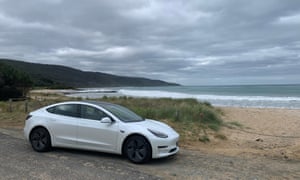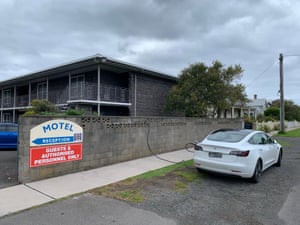Extract from The Guardian
With a rise in the availability of EV rentals – and a marked increase in charging stations – Oliver Pelling set out on an 800km trip along the Great Ocean Road
The first blunder of my all-electric road trip occurs in Lorne, some 145km from my Melbourne home.
I know, thanks to the PlugShare app – which maps most of the publicly available charging points in Australia – that there is a charger at Lorne Visitor Information Centre. What I don’t know, until I get there, is that this particular charger doesn’t fit my particular car.
I call Ben, whose Tesla Model 3 I’ve hired for the next couple of days to see if I’m missing anything. My practical knowledge of electric vehicles (EVs) is limited to the Scalextric slot cars I’d race against my dad as a child, and EVs have come a long way since then. Ben confirms that all I’m missing is an adaptor.

Ben reckons the whole adaptor thing isn’t really a big issue any more (I’m inclined to disagree). Anyone looking to go long-haul in an EV would do well to keep it in mind. Luckily, I’m being vigilant with my battery and have plenty left to get me to Apollo Bay where, according to the app, a couple more charging stations await.
I’m driving the length of the Great Ocean Road to Port Fairy (and back again) in a rented Tesla because, well, thanks to a few developments in the local EV scene over the past year or so, I can.
According to the Electric Vehicle Council (the national body representing the EV industry in Australia), the number of ultra-fast charging stations across Australia has surged 42% since July 2019, while the number of standard charging stations has increased by 16%.
A recent report based on stats from the Electric Vehicle Council reckons that, thanks to the expansion of the charging network, at least 10 of Australia’s most famous road trips (including Perth to Ningaloo, Pacific Coast, Grand Pacific Drive, Great Alpine Road, Tasmania’s East Coast and the Great Ocean Road) have been made more accessible to EVs.
But perhaps the most useful development for climate-conscious (or tech-curious) road-trippers – especially in this year of acutely domestic tourism – is the rise of EV sharing platforms.

According to the Evee CEO and founder, Slava Kozlovskii, while long-haul EV driving is getting easier, it still demands a little more thought and planning than a typical gasoline-powered trip. “There’s an informal rule for electric car road-tripping known as ‘ABC’,” says Kozlovskii. “It stands for ‘always be charging’. So whenever you stop, whenever your car is stationary, just always try to find a power point.”
As much as all this new charging infrastructure is helping open the country up to EVs, Kozlovskii reminds me that the good old-fashioned household socket already renders much of the country EV accessible (albeit with longer charging times). “There are more power sockets in Australia than there are petrol stations,” he explains.
I charge my car behind the Great Ocean Road Brewhouse in Apollo Bay, which takes the best part of three hours (to get from 5% to 90%). A supercharger could get me to full charge in around 30 minutes, but this isn’t one of them.

I press on to Port Fairy where, unable to charge overnight (my second and final faux pas of the trip), I find a charger at a nearby motel the following morning. After paying the motel owner $20 for a top-up, I’m on the road back to Melbourne (via a final charge in Apollo Bay). By trip’s end, I’ve driven close to 800km – along a famously winding and undulating road, which eats battery power much faster – on two charges (plus one that was supposed to be overnight).
For the most part, successful EV road-tripping simply requires a little more planning, a little more time, and a little more thought when it comes to route selection. A negligible price to pay for a low-impact excursion and the experience of driving an EV for yourself, if you ask me. Besides, if anyone’s idea of a ‘successful’ road trip is to get from A to B as fast as possible, they’re doing it wrong.
“It’s like when we moved from landlines to mobile phones,” says Behyad Jafari, the CEO of the Electric Vehicle Council. “Or when the internet came about, or emails. There are just new things to learn. It’s not a massive learning curve, but you do need to spend some time learning how a new technology works, and I think that’s a positive thing.”
Anyone who gets behind the wheel of one of these things will, I’m sure, find themselves excited not just about the future of electric vehicles, but about the increasingly accessible present too. There’s enough speed, comfort and class in the driving experience to entice even the most diehard petrolhead, and while charging might still be a little more hassle than refuelling, the open road now feels more open (and guilt-free) than I ever remember it.
And if you’re still not convinced that electric vehicles can really go the distance, you could always just hire one.
Car hire for this trip was provided by Evee
Tips for an EV road trip
Make sure you know the maximum range of your vehicle before departing; plot your charging points (with PlugShare); and double-check the types of chargers (and if you’ll need any additional adaptors) via the app. Look for superchargers along your route, if available. If using Evee or another car-sharing platform, the car’s owner will be a great resource for any charging questions you have along the way.
An increasing number of hotels, motels and even restaurants around Australia have EV chargers on site to encourage visitors, so a little extra research when you’re booking can pay dividends.
All-day driving will typically involve at least one charge, which could take up to three hours. Instead of seeing this as a negative, use your charging time as an opportunity to go eat, drink, explore and enjoy some non-driving activities before hitting the road again.

No comments:
Post a Comment